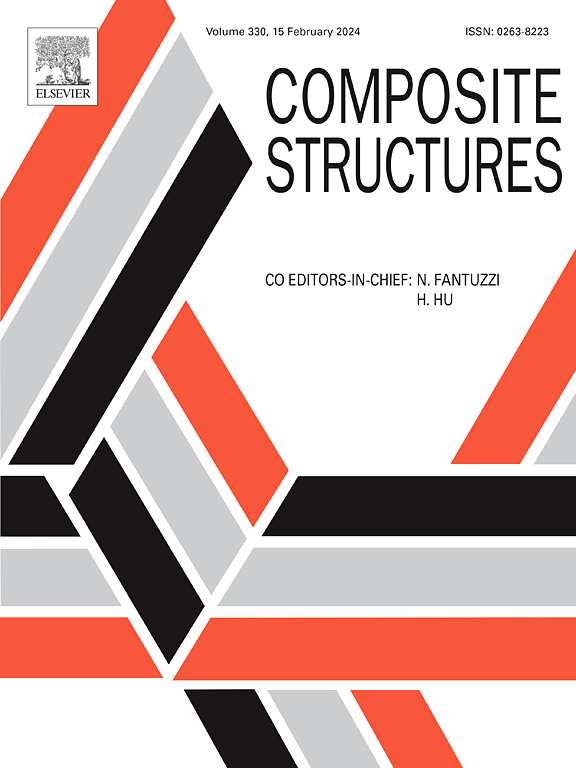具有降低泊松比的晶体激发细胞超材料作为TPMS的类似物
IF 6.3
2区 材料科学
Q1 MATERIALS SCIENCE, COMPOSITES
引用次数: 0
摘要
细胞超材料的增材制造在减轻运输和先进土木工程应用中的重量方面似乎很有前景。它提高了能源效率,减少了燃料和能源消耗,减少了二氧化碳排放。晶体激发材料在微观尺度上继承了具有高sp3和sp2杂化的碳同素异形体的TPMS(三周期最小表面)结构。然而,从晶体结构数据得出的TPMS拓扑能否超越理想TPMS的性能,目前还不确定。我们的研究结果表明,从泊松比的角度来看,使用新方法设计SC1碳和八碳(超立方)衍生的超材料的晶体启发结构是可行的。在这项工作中,使用选择性激光烧结(SLS)和高分辨率液晶显示器(LCD)光聚合的3D打印技术制造样品。进行了应力-应变压缩试验、泊松比实验测量、均匀化建模、平均曲率和高斯曲率的研究。均质化方法表明,晶体激发晶格的泊松比比其TPMS类似物低约20%,有时甚至更高,低约3倍。尽管泊松比降低,但力学性能仍与TPMS晶格相当。晶体激发的样品表现出增强的损伤容忍度,与TPMS相比,表现出更大的抗开裂性和延迟破坏性失效的发生。用平均曲率和高斯曲率的特殊分布解释了晶体激发的超材料泊松比的降低。由于泊松比是一个重要的力学参数,这解释了晶体激发晶格力学性能的改善。这一观察结果显示了晶体启发拓扑的潜力。所研究的超材料在需要高能量吸收、各向同性性能和承载能力的商业领域以及在结构和机械工程中具有广泛的适用性,这些领域在所有方向上的一致性能至关重要,例如在建筑、桥梁和车辆建造中。本文章由计算机程序翻译,如有差异,请以英文原文为准。

Crystal-inspired cellular metamaterials with reduced Poisson’s ratio as analogues of TPMS
Additive manufacturing of cellular metamaterials appears to be promising in weight reduction for transportation and advanced civil engineering applications. It provides improved energy efficiency, reduces fuel and energy consumption, and CO2 emissions. Crystal-inspired materials inherit their TPMS (Triply Periodic Minimal Surface)-like architecture from carbon allotropes with high sp3 and sp2 hybridization at the microscale. However, it is still uncertain whether materials with a TPMS topology derived from crystal structure data can surpass the properties of ideal TPMS. Our findings indicate that this is feasible using new approach in design of crystal-inspired structures for SC1 carbon and octacarbon (supercubane)-derived metamaterials in terms of the Poisson’s ratio. In this work the samples were manufactured using the 3D printing techniques of selective laser sintering (SLS) and high-resolution liquid crystal display (LCD) photopolymerization. Stress–strain compression tests, experimental measurements of Poisson’s ratio, homogenization modeling, investigation of mean average and Gaussian curvatures in metamaterials were performed. The homogenization method showed that crystal-inspired lattices demonstrate a Poisson’s ratio approximately ∼ 20 % lower than that of their TPMS analogs, sometimes even more, up to ∼ 3 times lower. Despite this reduction in Poisson’s ratio, the mechanical properties remained comparable to those of TPMS lattices. Crystal-inspired samples exhibit enhanced damage tolerance, showing significantly greater resistance to cracking and a delayed onset of destructive failure compared to their TPMS counterparts. The reduced Poisson’s ratio of crystal-inspired metamaterials was explained by the peculiar distribution of mean and Gaussian curvature in such metamaterials. Since Poisson’s ratio is an important mechanical parameter, this explains the improved mechanical performance of crystal-inspired lattices. This observation shows the potential of crystal-inspired topologies. The metamaterials investigated demonstrate broad applicability in commercial sectors demanding high energy absorption, isotropic properties, and load-bearing capacity, as well as in structural and mechanical engineering where consistent properties across all directions are crucial, such as in building, bridge, and vehicle construction.
求助全文
通过发布文献求助,成功后即可免费获取论文全文。
去求助
来源期刊

Composite Structures
工程技术-材料科学:复合
CiteScore
12.00
自引率
12.70%
发文量
1246
审稿时长
78 days
期刊介绍:
The past few decades have seen outstanding advances in the use of composite materials in structural applications. There can be little doubt that, within engineering circles, composites have revolutionised traditional design concepts and made possible an unparalleled range of new and exciting possibilities as viable materials for construction. Composite Structures, an International Journal, disseminates knowledge between users, manufacturers, designers and researchers involved in structures or structural components manufactured using composite materials.
The journal publishes papers which contribute to knowledge in the use of composite materials in engineering structures. Papers deal with design, research and development studies, experimental investigations, theoretical analysis and fabrication techniques relevant to the application of composites in load-bearing components for assemblies, ranging from individual components such as plates and shells to complete composite structures.
 求助内容:
求助内容: 应助结果提醒方式:
应助结果提醒方式:


